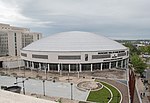Bicentennial Capitol Mall State Park

Bicentennial Capitol Mall State Park, commonly known as Bicentennial Mall, is an urban linear landscaped state park in downtown Nashville, Tennessee. The park is located on 19 acres (77,000 m2) north-northwest of the Tennessee State Capitol, and highlights the state's history, geography, culture, and musical heritage. Receiving more than 2.5 million visitors annually, it is the most visited of Tennessee's 56 state parks.The park is modeled on the National Mall in Washington, D.C., and was first conceptualized in 1989 by former Governor Ned McWherter as part of the planning for the state of Tennessee's bicentennial commemoration. Groundbreaking occurred on June 27, 1994, and the park opened to the public on June 1, 1996, the 200th anniversary of Tennessee's statehood.
Excerpt from the Wikipedia article Bicentennial Capitol Mall State Park (License: CC BY-SA 3.0, Authors, Images).Bicentennial Capitol Mall State Park
Path of Volunteers, Nashville-Davidson
Geographical coordinates (GPS) Address Nearby Places Show on map
Geographical coordinates (GPS)
| Latitude | Longitude |
|---|---|
| N 36.1707 ° | E -86.7875 ° |
Address
Path of Volunteers
Path of Volunteers
37219 Nashville-Davidson
Tennessee, United States
Open on Google Maps









